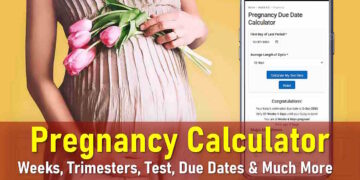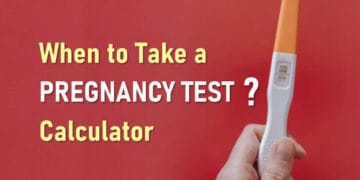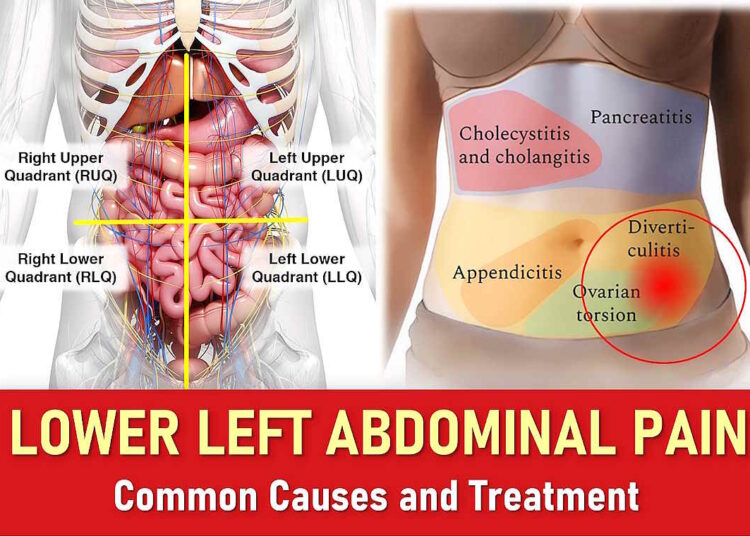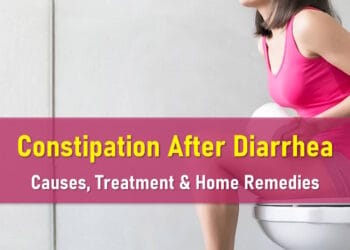Pain in the lower left abdomen can arise from a variety of causes. This discomfort, which is often referred to as left lower quadrant (LLQ) pain, specifically targets the left side of the lower abdomen. It is sometimes called left iliac fossa (LIF) pain, though this term refers to a smaller region within the left side of the abdomen.
Where is My Left Lower Abdomen?
 The lower left abdomen is located in the section of your abdomen beneath the ribs and above the pubic area. If you were to divide your abdomen into four quarters, the lower left quadrant is the area located to the left of your belly button and below the waistline. This region is home to several vital organs, which can contribute to pain when they are irritated or affected by certain medical conditions.
The lower left abdomen is located in the section of your abdomen beneath the ribs and above the pubic area. If you were to divide your abdomen into four quarters, the lower left quadrant is the area located to the left of your belly button and below the waistline. This region is home to several vital organs, which can contribute to pain when they are irritated or affected by certain medical conditions.
What is Found in the Lower Left Abdomen?
The organs and structures located in the left lower abdomen include:
- The small bowel (ileum)
- Parts of the large bowel (colon)
- The rectum
- The left ureter (connected to the kidney)
- Left ovary and Fallopian tube (in women)
- Skin, nerves, and blood vessels in that area
Common Causes of Lower Left Abdomen Pain
Left lower abdomen pain can have numerous causes. While it is important to see a healthcare professional for an accurate diagnosis, here are some of the more common conditions that may lead to pain in this area:
Constipation
When the intestines become full of stool, it can cause discomfort throughout the abdomen, including the lower left side. In cases of constipation, you may notice a decrease in the frequency of bowel movements and the presence of hard, pellet-like stools.
Gastroenteritis and Food Poisoning
Both gastroenteritis and food poisoning can cause pain in the abdomen, along with symptoms like nausea, vomiting, and diarrhea. The pain often decreases after passing diarrhea, but it can be widespread across the abdomen.
Irritable Bowel Syndrome (IBS)
IBS is known for causing crampy, bloated abdominal pain. It often alternates between diarrhea and constipation. Diagnosis is typically based on a pattern of symptoms when other causes have been ruled out. Tests may be conducted to exclude other possible conditions.
Diverticulitis
Diverticulitis refers to inflammation in the pouches (diverticula) that form in the colon, particularly in the sigmoid colon, which is located in the left lower abdomen. This condition often results in fever, changes in bowel habits, and localized pain. Diverticulitis is a common cause of LLQ pain in adults.
Colon and Rectal Cancer
Severe, persistent pain in the lower left abdomen, along with bloating and difficulty passing stool or gas, could indicate the presence of colon or rectal cancer. These cancers often affect the left side of the colon, especially the descending and sigmoid parts. Symptoms may also include unexplained weight loss, fatigue, changes in bowel movements, and blood in the stool.
It’s important to seek immediate medical attention if you suspect cancer, especially if accompanied by the symptoms mentioned.
Trapped Inguinal or Femoral Hernia
An inguinal or femoral hernia occurs when a portion of the bowel or other tissue pushes through a weakness in the abdominal wall, typically near the left groin where the lower abdomen meets the thigh. If the hernia becomes trapped and cannot be pushed back into the abdomen, it is termed “incarcerated.” This condition often results in a tender swelling in the left groin area and can cause pain in the groin and abdomen, which may radiate across the whole abdomen. Nausea and vomiting are common symptoms associated with this condition. Immediate medical attention is required to avoid complications.
Can Kidney Infections Cause Left Lower Abdomen Pain?
A kidney infection (pyelonephritis) can cause pain throughout the urinary tract, which may extend to the left lower abdomen. However, pain typically affects not just the LLQ but also the left upper quadrant or loin. In addition to the abdominal pain, kidney infections often cause pain when urinating, frequent urination, fever, chills, and an overall sense of illness.
Causes of Left Lower Abdomen Pain in Women
Mittelschmerz
Mittelschmerz refers to pain that occurs during ovulation, typically around the middle of the menstrual cycle. This pain can be sharp and severe but usually subsides within a few minutes. It is often felt on one side of the lower abdomen and may alternate sides each month, depending on which ovary releases the egg.
Pelvic Inflammatory Disease (PID)
PID often causes pain on both sides of the abdomen, but it can also manifest as left lower abdomen pain. The pain tends to worsen during sexual intercourse. Additional symptoms include abnormal vaginal bleeding (especially between periods or after sex) and a change in vaginal discharge, which may be unpleasant in smell or appearance.
Ovarian Torsion
Ovarian torsion, or twisted ovary, occurs when an ovary becomes twisted, often due to a fluid-filled cyst. This condition causes sudden and severe abdominal pain, which may be constant or intermittent. It requires prompt medical attention to prevent damage to the ovary.
Endometriosis
Endometriosis is a condition where tissue similar to the lining of the uterus grows outside of it. It can cause constant pain in the lower abdomen, which is typically worse before, during, and immediately after menstruation. While the pain can be widespread, it is often localized to the lower left abdomen in some women.
Ectopic Pregnancy
If you think you might be pregnant and are experiencing LLQ pain, it could be a sign of an ectopic pregnancy, which requires urgent medical attention. The pain may start suddenly or worsen gradually over a few days, becoming severe. Vaginal bleeding may occur, although it may not be similar to a normal period, sometimes appearing lighter or darker. Other symptoms include fainting, dizziness, or pain while passing stool. Shoulder-tip pain may also develop as a result of internal bleeding irritating the diaphragm.
If you suspect an ectopic pregnancy, especially after using emergency contraception, seek immediate help.
For more information, see detailed article on Ectopic Pregnancy.
Ovarian Cancer
Ovarian cancer can present as pain or a feeling of pressure in the lower abdomen, which may affect one side or the entire area. Women with ovarian cancer may notice changes in bowel habits, as well as bloating. If these symptoms persist, it is important to seek a healthcare provider’s advice.
For additional details, please see detailed article on Ovarian Cancer.
Left Lower Abdomen Pain Causes in Men
Pain originating from the left side of the scrotum can radiate to the left lower abdomen. However, the pain in the scrotum is often more intense than in the abdomen. This can indicate several conditions that require medical assessment to ensure proper diagnosis and treatment.
Torsion of the Testicle
Testicular torsion occurs when the spermatic cord twists, cutting off the blood supply to the testicle. This condition leads to severe pain in the scrotum and lower abdomen. While it is most common in teenage boys, young adult men can also be affected. It is less frequent in men over the age of 25 but can still occur at any age. The testicle becomes extremely tender, and immediate medical attention is necessary to prevent permanent damage.
Epididymo-orchitis
Epididymo-orchitis refers to the inflammation of the testicle and the tubes surrounding it (epididymis), usually caused by an infection. The affected side of the scrotum will swell, become very red, and tender to the touch. Additional symptoms may include pain while urinating or discharge from the penis.
Other Possible Causes of Left Lower Abdomen Pain
Inflammatory Bowel Disease (IBD)
Inflammatory bowel diseases such as Crohn’s disease and ulcerative colitis cause inflammation of the gut lining. This is different from irritable bowel syndrome (IBS). IBD is characterized by symptoms like diarrhea, which may sometimes be mixed with blood. These conditions require medical management to control inflammation and prevent complications.
Sigmoid Volvulus
Sigmoid volvulus occurs when the sigmoid colon, which is the last part of the large intestine, twists on itself, leading to a blockage. This condition causes colicky pain and significant bloating in the abdomen. It is most common in elderly individuals, especially those with long-term constipation. Sigmoid volvulus is a medical emergency that requires surgical intervention to avoid serious complications.
Kidney Stones
Kidney stones are hard deposits that form in the kidneys or the urinary tract, including the ureter. When a stone moves into the left ureter, it may cause pain that starts in the left side of the back (loin) and radiates to the lower abdomen (LLQ), and may even extend to the groin or testicle in men. The pain can be accompanied by blood in the urine and discomfort while urinating. Immediate medical attention is necessary to address kidney stones and prevent further complications.
Shingles
Shingles, caused by the reactivation of the varicella-zoster virus, can sometimes cause pain before a rash appears. The pain is often described as sharp or burning and can affect various areas of the abdomen, including the left lower quadrant. Shingles can be accompanied by a rash and flu-like symptoms, so if you suspect shingles, it’s important to seek medical attention for proper management.
Abdominal Aortic Aneurysm
An abdominal aortic aneurysm (AAA) is a swelling of the aorta, the body’s largest blood vessel, within the abdomen. Although an AAA may not produce symptoms, it can sometimes cause pain before it ruptures. The pain is typically felt in the back or side of the abdomen but may also radiate to the left lower abdomen. Prompt diagnosis and treatment are essential to manage the risk of rupture.
What Else Could It Be?
The list of possible causes for left lower quadrant (LLQ) pain is extensive, and many other conditions could contribute to discomfort in this area. Pain from your back or hip, for example, could be “referred pain,” meaning the source of the pain is elsewhere but is felt in the LLQ.
Muscular strains or pulls can also result in LLQ pain. If muscle-related pain is the issue, moving the muscle in question will likely worsen the pain. However, if you remain still, the pain may subside.
Why does my lower left abdomen hurt when I take a deep breath?
Lower left abdominal pain that worsens when taking a deep breath may indicate:
- A hernia
- Kidney stones
- Testicular or ovarian torsion
- Diverticulitis
- A diaphragm injury
Seek medical attention promptly if the pain intensifies or is accompanied by symptoms such as fever, nausea, or vomiting.
What Are the Usual Tests for Left Lower Quadrant Pain?
Your doctor will begin by narrowing down the potential causes of LLQ pain through a detailed conversation and physical examination. Sometimes, the diagnosis can be made based on these alone. For example, if the doctor identifies a rash indicative of shingles, further testing may not be required.
Typically, your doctor will examine the painful area in the abdomen and may check other parts of your body as well. For women, an internal examination may be necessary to rule out conditions like pelvic inflammatory disease, while men may need a scrotum and testicle examination. You will usually be offered a chaperone during intimate exams.
Tests may include:
- Urine tests to check for infection.
- Swabs (for women) to check for infections like chlamydia or for men, a urine test for similar infections.
- Blood tests to:
- Assess liver and kidney function.
- Rule out infection or inflammation.
- Check for anemia.
- Measure blood sugar levels.
What Other Tests Might Be Needed for Left Lower Quadrant Pain?
Depending on the results of the initial examination and tests, further investigations may be required. In some cases, no additional tests are needed if conditions like constipation or shingles are diagnosed. However, if a bowel issue is suspected, your doctor may recommend a colonoscopy or other imaging tests, such as a CT scan or ultrasound, to examine your large intestine and kidneys.
For women, imaging may also be used to examine the ovaries and fallopian tubes. In some cases, X-rays, sigmoidoscopy, or MRI scans may also be needed.
If an ectopic pregnancy or testicular torsion is suspected, immediate medical action may be required, often involving emergency surgery with minimal diagnostic testing beforehand.
It’s important to note that not everyone will need all these tests, and some people may not need any additional tests at all.
Lower Left Abdominal Pain Treatment
Treatment for lower left abdominal pain depends on the underlying cause. Consulting a doctor is essential to identify the root issue and determine the most effective course of action. Below is an overview of treatment options, home care tips, preventive measures, and when to seek medical attention.
Treatment Options
Mild Cases
For mild cases, home remedies and over-the-counter (OTC) medications can often provide relief:
- Pain Management: Nonsteroidal anti-inflammatory drugs (NSAIDs) or acetaminophen are common choices.
- Dietary Adjustments: Consuming light broths or herbal teas—such as peppermint, licorice, or ginger—can soothe the digestive system. Rest and staying hydrated are also key strategies.
Specific Conditions
- Infections: Conditions like diverticulitis may require antibiotics and rest.
- Structural Issues: Problems such as hernias or intestinal blockages often necessitate surgical intervention.
- Constipation and Gas: These are typically managed with dietary changes and, in severe cases, laxatives.
- Chronic Conditions: Long-term dietary management and symptom-specific treatments are effective for conditions like irritable bowel syndrome (IBS) or inflammatory bowel disease (IBD).
- Food Intolerances: Identifying and avoiding trigger foods, such as lactose for those with lactose intolerance, is essential.
Home Care Tips for Mild Abdominal Pain
If your discomfort is mild, you can try the following home care measures:
- Sip water or clear fluids in small amounts. Sports drinks can be consumed sparingly, but individuals with diabetes should monitor blood sugar levels closely and adjust medications if necessary.
- Avoid solid foods for a few hours after symptoms begin.
- If vomiting occurs, wait six hours before consuming mild foods like rice, applesauce, or crackers. Avoid dairy products until symptoms improve.
- For pain higher up in the abdomen, especially after meals, antacids may provide relief from heartburn or indigestion. Avoid citrus, fatty foods, fried items, caffeine, alcohol, and carbonated beverages.
- Do not take any medication without consulting a healthcare provider.
Preventing Abdominal Pain
Taking proactive steps can help reduce the likelihood of abdominal pain:
- Stay hydrated by drinking plenty of water daily.
- Eat smaller meals more frequently to avoid overburdening the digestive system.
- Exercise regularly to promote overall health.
- Limit foods that cause gas or bloating.
- Ensure meals are well-balanced, high in fiber, and rich in fruits and vegetables.
When to Seek Medical Attention
Some symptoms require immediate medical evaluation. Call 911 or seek emergency care if you experience any of the following:
- Severe pain that starts suddenly or becomes unbearable.
- Inability to pass stool, especially if accompanied by vomiting.
- Vomiting blood or noticing blood in your stool (bright red, maroon, or dark tarry black).
- Pain radiating to your chest, neck, or shoulders.
- Sharp pain between your shoulder blades accompanied by nausea.
- Tenderness or rigidity in your abdomen.
- Pregnancy or the possibility of pregnancy. (take a pregnancy test before seeing a doctor).
- Difficulty breathing.
- Recent injury to the abdomen.
- You have lost weight without attempting to do so.
- You experience sudden or intense pain in the scrotum.
Contact your healthcare provider for non-emergency symptoms such as:
- Abdominal discomfort lasting longer than a week.
- Pain worsening over 24 to 48 hours, or occurring with nausea and vomiting.
- Bloating persisting for more than two days.
- Burning sensation or pain while urinating.
- Diarrhea lasting more than five days.
- Fever over 100°F (37.7°C) in adults or 100.4°F (38°C) in children.
- Persistent poor appetite or unexplained weight loss.
- Inability to keep down food or liquids.
Conclusion
Pain in the lower left abdomen can arise from various causes, ranging from minor digestive issues to more serious medical conditions. Understanding the potential sources of discomfort and recognizing associated symptoms can help in seeking timely medical attention. Early diagnosis and treatment are key to managing underlying conditions effectively and preventing complications.
If you experience persistent, severe, or worsening pain, consult a healthcare professional to determine the cause and explore appropriate treatment options. Taking proactive steps to maintain digestive health and overall wellness can also help minimize the risk of recurring abdominal pain.





























